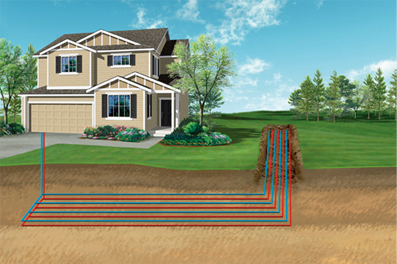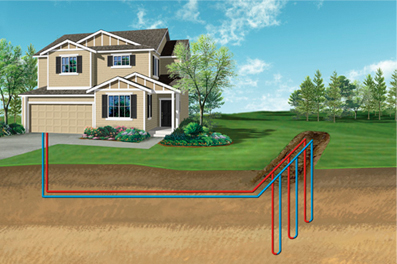Residential & commercial geothermal systems
your field: a source of energy
Geothermal energy: a proven technique of Quebec's experts.
Geothermal energy is a technology that converts the energy stored in soil, surface water and groundwater into usable energy to heat and cool residential buildings. A circuit may have several configurations, but there are three basic loops types : vertical, horizontal and in a lake (or pond)
Horizontal loops
Ditches between 1 and 3 m wide are dug. Loops configurations can be either undulate or spiral. Many different configurations have been tested and then approved. Do not forget to ask the contractor for referrals, he can often show you photographs of loops they have installed in the past.


Vertical loops
Vertical loops are buried 15 to 100 m deep in boreholes and their circumference is 10 to 12 cm. The main advantage of vertical loop is the fact that it requires less space than horizontal loop.
To learn more about the way geothermal systems work, visit the Hydro-Quebec website presenting a more detailled explanation of the components as well as the advantages and disadvantages of the energy source.
AdVANTAGES:
A very profitable system, economically strong with renewable clean energy
The graphics below compares the costs of different energy sources and the annual cost of heating, cooling and domestic hot water for a single family home during a period of 20 years. Giving that energy costs is always increasing, the savings you will make using geothermal systems will be very significant over a long period of time.
Costs of different energy sources for heating * Estimated annual fuel costs for a single family home *

* Based on average fuel prices in Quebec Winter 2004-2005
Reliability and comfort all year round
More than 2,000 geothermal heat pumps were supplied by Airtechni in Quebec since 1975, and over 80% are still in operation. High performance systems such as ClimateMaster, GeoComfort, will incorporate the most advanced control and communication techniques that improved air quality and give a smoother, more constant heat flow.
Environment:
Geothermal system does not emit CO2.
46% of the solar energy is stored in soil. Thnaks to geothermal energy a portion of this energy can be recovered and used to heat buildings. Globally, electricity production from geothermal systems is around 50 TWh, which puts this clean energy source in 3rd place after hydro (2600 TWh) and biomass (157 TWh).
Canadian clean energy dialogue
In December 2017, the Generation Energy council publishes a report mentionning the desire of over 380 000 Canadians for a carbon neutral energetic future as well as describing the different suggestions from the public consultations to achieve that goal.
Discover the highlights on the subject of an eco-energetic future in Canada.
Canadian Environmental Sustainability Indicators:
Three major areas of concern to Canadians:
- Air quality
- Water quality
- Greenhouse gas emissions
The fight against climate change requires immediate and concerted actions. It is not only the duty of our government and the scientific community to fix the problems, but to all the people, institutions and companies that make our society.

